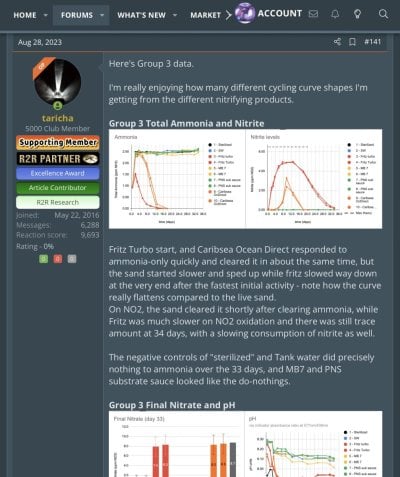On whether or not caribsea live sand has ammonia reducing bacteria:

Tarichas testing, that says it reduced ammonia quite well

the sellers have the highest bar for accuracy vs common web opining.
When you make a wrong call it seems like boosting up sales still happens. If GlassMunky made a wrong call I would just ignore him, but I wouldn’t think he’s trying to steer people into something for cost it would just be two 20yr online reefers still butting heads.
substrate that you’ve verified for cost matters if the claim that bagged sand couldn't reduce ammonia was made.
I get the constant hint that only your testing is valid
I think you’re on the starting wave of the most powerful testing for reef tank biota we might ever see.
In a few years we will be able to use it to make sustained and real changes in reef tanks, the utility between the test readout and how hobbyists make sustained improvements will be high
in my opinion the utility is being oversold currently but in no way do I think it’s not the spear tip of a revolutionary industry coming about
yours was the first I knew of doing the tests for reef tanks at home
as a seller account, throngs of people believe anything you say about bacteria. They don’t know of those on field conflicts.
I thought you came into the hobby fast then tried to change up some stuff I'm not sure is polished and ready yet.
Tarichas testing, that says it reduced ammonia quite well

the sellers have the highest bar for accuracy vs common web opining.
When you make a wrong call it seems like boosting up sales still happens. If GlassMunky made a wrong call I would just ignore him, but I wouldn’t think he’s trying to steer people into something for cost it would just be two 20yr online reefers still butting heads.
substrate that you’ve verified for cost matters if the claim that bagged sand couldn't reduce ammonia was made.
I get the constant hint that only your testing is valid
I think you’re on the starting wave of the most powerful testing for reef tank biota we might ever see.
In a few years we will be able to use it to make sustained and real changes in reef tanks, the utility between the test readout and how hobbyists make sustained improvements will be high
in my opinion the utility is being oversold currently but in no way do I think it’s not the spear tip of a revolutionary industry coming about
yours was the first I knew of doing the tests for reef tanks at home
as a seller account, throngs of people believe anything you say about bacteria. They don’t know of those on field conflicts.
I thought you came into the hobby fast then tried to change up some stuff I'm not sure is polished and ready yet.
Last edited:
























